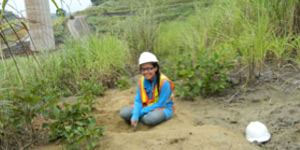By Lina Pérez Ángel
My name is Lina Perez Angel and I am a student at University de Los Andes (Colombia). Thanks to a Geology class I took with Camilo Montes, I had the chance to volunteer with Carlos Jaramillo at the Center for Tropical Paleoecology and Archeology (CTPA) in the Smithsonian Tropical Research Institute-Panama (STRI). I did not know whether to continue studying Environmental Engineering or switch to Geosciences. I was not familiar with the questions studied in the fields of geology and paleontology. At STRI, I had the opportunity to meet a group that showed them to me.

During my time in Panama I participated in many field and lab activities. One of the field trips was in Piña (Nuevo Chagres, Colón), where I helped dig out a giant swordfish fossil vertebra. Another field trip was to the Gatun formation near Colon, where I found shark teeth among the millions of fossil invertebrates. But I spent most of the time in the Canal Zone where I worked with the PCP-PIRE group. We measured stratigraphic columns, described each layer, looked for fossils, collected samples for screen-washing, helped make a plaster jacket with a rhinoceros scapula and learned to correlate this information to each station in the Canal.
When not in the field, I was in the lab where I also learned a lot. I helped clean, organize and classify fossils from Castilletes (Guajira-Colombia). I learned to manage the database using and inserting information. I was also introduced to palynology (spores and pollen) and then identified some samples in the microscope. I did screen-washing and picking of small fossil teeth and otoliths.
All of these activities were very rewarding. It was all very new to me. I loved learning what everything I was doing was about and what everyone in the lab was doing. I think the most important thing I learned was to work in a research group, see what it was like, how they worked and how they worked together in so many projects.
This experience helped me realize what I want to study and do for the rest of my life. It is not easy to know what you want to study when you are 16 years old. I lasted two years in a major that did not interest or motivate me. I never imagined that I would like another major so much to the point that I would read and look for information just for fun. Now, thanks to this experience at STRI, I decided to transfer to Geosciences. I want to continue studying and learning about the geology, paleontology, tectonics and climate of the past. I want to continue to have that feeling of fascination for all things related to this science.
Por Lina Pérez Ángel
Mi nombre es Lina Pérez Ángel y estudio en la Universidad de Los Andes (Colombia). Gracias a una clase de geología con Camilo Montes, tuve la oportunidad de hacer un voluntariado en el Smithsonian Tropical Research Institute en el Centro de Paleocología y Arqueología Tropical-CTPA con Carlos Jaramillo. En ese momento me encontraba en un dilema: no sabía si seguir estudiando Ingeniería Ambiental o cambiarme a Geociencias. No sabía de qué se trataba el mundo de la geología ni la paleontología y en STRI tuve la oportunidad de conocer a un grupo de trabajo que me mostró de qué se trataba esto.

Durante mi estadía en Panamá realicé muchas actividades tanto en campo como en el laboratorio. Realicé varias salidas de campo. Una de ellas fue a Piña (Nuevo Chagres, Colón) dónde ayudé a desenterrar una vertebra fósil de un pez espada gigante. Otra fue a la formación Gatun cerca de Colón donde hay millones de fósiles de invertebrados y dónde encontré dientes de tiburón. Pero donde más estuve fue en el canal. Aquí junto con un grupo del PCP-PIRE levantamos columnas estratigráficas, describimos cada capa que mediamos, buscamos fósiles, sacamos muestras para hacer screen-washing, aprendí a hacer un cama de yeso con una escápula de rinoceronte que uno de ellos encontró y aprendí a correlacionar todo esto en cada estación del canal.
Cuando no estaba en campo me encontraba en el laboratorio, donde también aprendí bastante. Ayudé a limpiar, organizar y clasificar unos fósiles de Castilletes (Guajira). Aprendí a manejar la base de datos usando e introduciendo información en esta. También tuve una introducción a la Palinología (esporas y polen) y luego identifiqué algunas muestras en el microscopio, hice screen-washing y luego picking para sacar pequeños fósiles como dientes y otolitos.
Todas estas actividades fueron realmente enriquecedoras. Todo era muy nuevo para mí y me encantaba saber qué era todo lo que hacíamos y qué hacían todos en el laboratorio. Creo que lo más importante que aprendí fue a trabajar en un grupo de investigación, ver de qué se trataba, cómo trabajaban y cómo entre todos sacaban adelante tantos proyectos.
Esta experiencia permitió darme cuenta qué era lo que quería estudiar y hacer el resto de mi vida. Realmente no es fácil saber qué quieres estudiar cuando sales del colegio a los 16 años. Duré dos años en una carrera que no me motivaba ni me gustaba tanto y nunca imaginé que otra carrera me llegara a gustar a tal punto de leer y buscar de este tema por gusto. Ahora que gracias a esta experiencia decidí cambiarme a Geociencias, quiero seguir estudiando y aprendiendo sobre la geología, la paleontología, la tectónica y el clima del pasado. Esto me hace seguir queriendo tener esa sensación de fascinación por todo lo relacionado con esta ciencia.